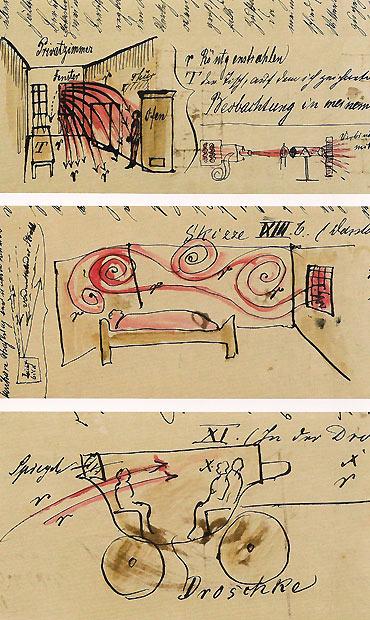
Dakle, netko upravlja tvojim ponašanjem uz pomoć tajanstvenih strojeva? Nekada si morao biti lud da povjeruješ u takvo nešto.
Jakob Mohr (1884–1940) is one of the most well known artists of the renowned Prinzhorn Collection. As of 1911, the assistant gardener spent six years as a psychiatric patient because he believed that he was influenced by electric waves. He made numerous drawings of these experiences and their operating principle, which are meanwhile among the most popular works in the collection. Mohr’s drawings are as visionary as they are fantastical, frightening, and also bizarre. In addition to the drawings, he also created self-portraits that show him as a high-ranking figure. In the new publication, all the drawings that have been preserved as well as a selection of texts by Mohr are published and explained for the first time.





[Tausk's] essay, “On the origin of the ‘Influencing Machine’ in Schizophrenia,” which has since become a classic in psychiatric literature, had just been published.
In the article, Tausk described the elaborate mechanical devices that paranoid schizophrenics invent in their imaginations to explain away their mental disintegration. As the boundaries between the schizophrenic’s mind and the world break down, they often feel themselves persecuted by “machines of a mystical nature,” which supposedly work by means of radio-waves, telepathy, x-rays, invisible wires, or other mysterious forces. The machines are believed to be operated by enemies as instruments of torture and mind-control, and the operators are thought to be able to implant and remove ideas and feelings, and inflict pain, from a distance.
Influencing Machines are described by their troubled inventors as complex structures, constructed of “boxes, cranks, levers, wheels, buttons, wires, batteries and the like.” Sometimes these devices are thought to be their doubles, unconscious projections of their fragmented bodily experience. Patients will typically invoke all the powers known to technology to explain their obscure workings. Nevertheless, they always transcend attempts at giving a coherent account of their function: “All the discoveries of mankind,” Tausk asserts, “are regarded as inadequate to explain the marvelous powers of this machine.”
Tausk took his term from an apparently magical device invented in 1706 by Francis Hauksbee, a student of Isaac Newton. His “Influence Machine” was a spinning glass globe, which cracked like lightning when touched, transmitting an electrical spark and emitting a greenish neon light when rubbed—a mysterious luminosity which was called “the glow of life.” These apparently supernatural effects were caused by the introduction of static electricity into a vacuum; it worked like the shimmering vacuum tube of the modern TV. Its psychological incarnation had similarly mesmerizing effects: “The influencing machine,” Tausk wrote, “makes the patients see pictures. When this is the case, the machine is generally a magic lantern or cinematograph. The pictures are seen on a single plane, on walls or windowpanes; unlike typical visual hallucinations, they are not three-dimensional.” - Christopher Turner
http://www.cabinetmagazine.org/
The Judicial Murder of Jakob Mohr A film by Eva Koťátková
2016.
The Judicial Murder of Jakob Mohr is a theatrical collage presenting to the audience the case of the psychiatric patient and artist Jakob Mohr. Mohr suffered from the delusion that his behaviour was controlled by his doctor by means of a mysterious machine. The scene of Mohr’s drawing Judicial Murder, which depicts Mohr as defendant, the doctor, the influencing machine and the court, is used as the setting for assemblies or unusual conferences in which Mohr is presented as an artist, patient and criminal and in which not only Mohr’s visions, but also scenes and figures by other Art Brut artists claim their right to existence.
Nema komentara:
Objavi komentar